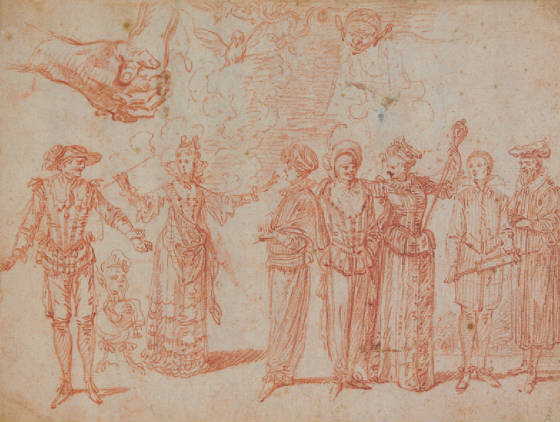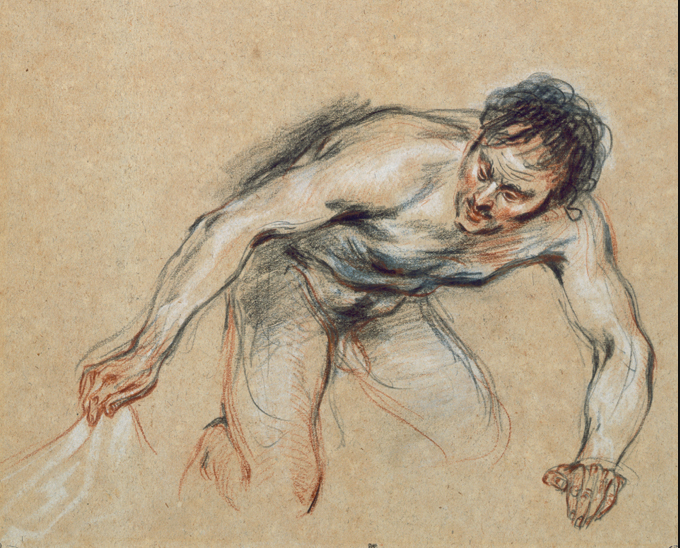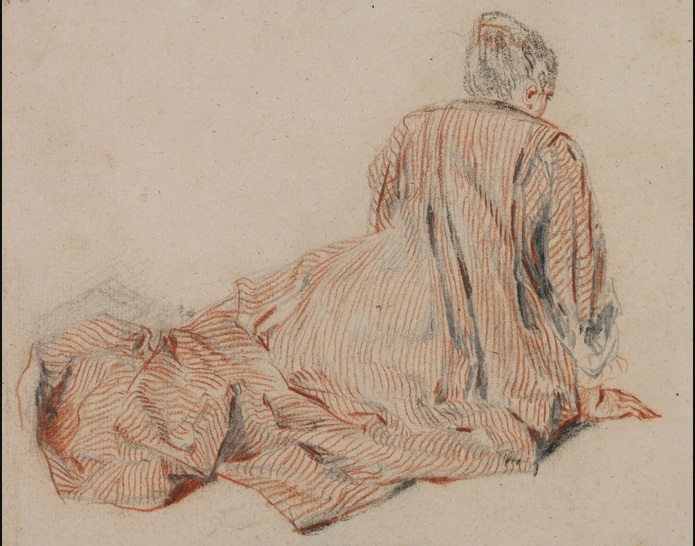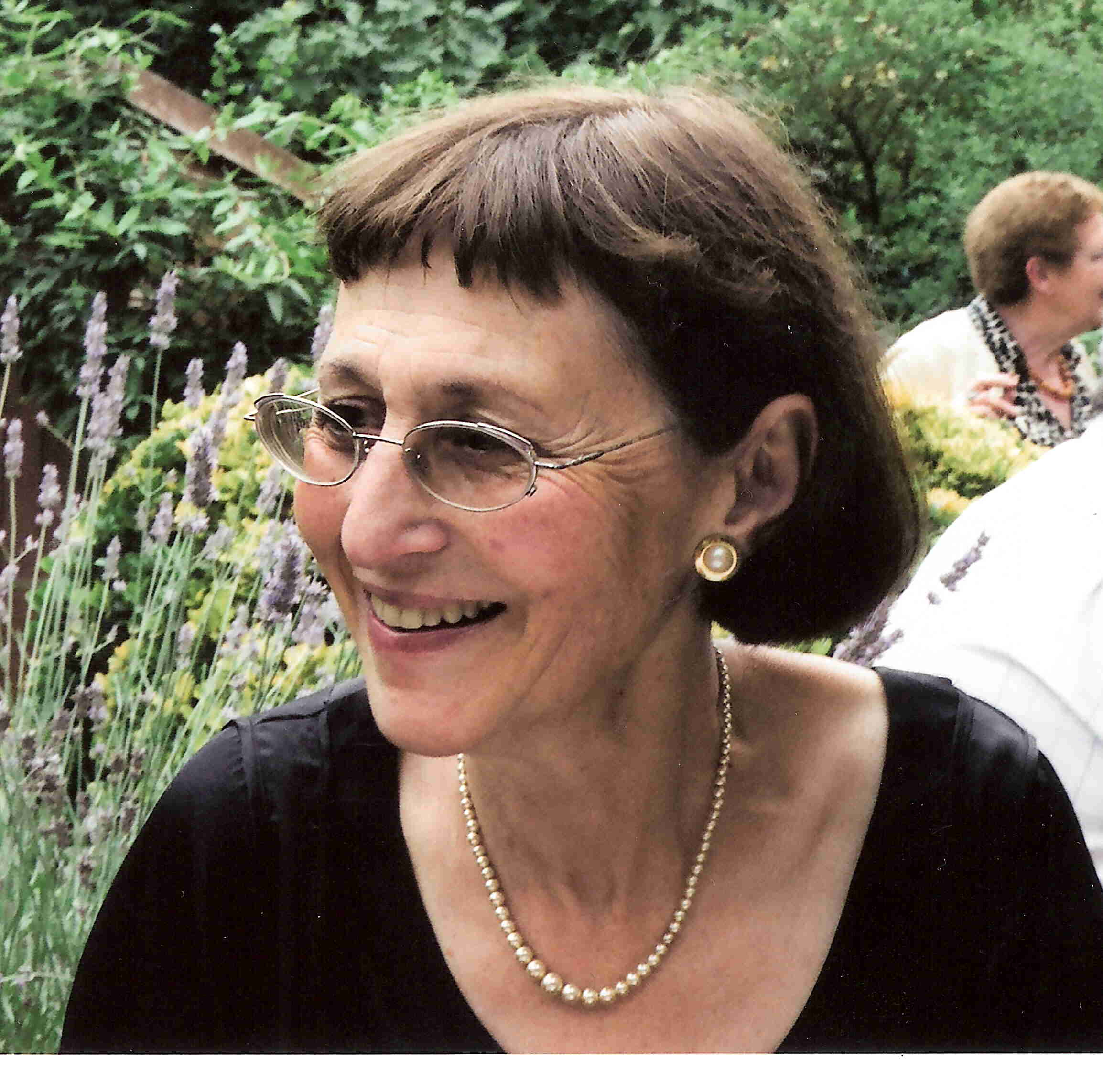
|

|

Jean-Antoine Watteau, Studies of Actors, a Pair of Hands and a Fragment of an Arabesque (c.1711). Photo © Hessisches Landesmuseum, Darmstadt.
Watteau’s Drawings: Virtuosity and Delight at the Royal Academy
By Anna Leung
Antoine Watteau died in 1721 at 37, the same
age at which Raphael died. Two years earlier he had travelled to London to
consult with Richard Mead, a highly reputable doctor and an admirer of his
work. As well as searching for a remedy for his tubercular condition he may
well have thought to rescue his finances. Like many others in France, where
Louis XV had adopted the Scotsman John Law’s economic system in order to
stimulate an economy worn down by the successive military adventures of his
predecessor, the Sun King Louis Quatorze, Watteau had been caught up in the
failure of Law’s speculative financial system that, culminating in the
Mississippi Bubble, was the first casualty of boom and bust economics based not
on gold but on paper credit in the emerging modern period.
Indeed what strikes us as we wander through
this exhibition is the modern feel imparted by Watteau’s sketches, which he
suggestively referred to as his ‘pensees a la sanguine’ [Editor’s Note: This phrase should
be translated in this context as ‘thoughts in red chalk,’ though it could also
mean ‘bloody thoughts’]. At the same time as they capture a world of social
encounters they also reveal an interior world that belongs exclusively to
Watteau. Interestingly this quite
probably would not have seemed to be the case were we to have first encountered
Watteau’s paintings at a separate companion exhibition at the Wallace
Collection. Contrasted with Watteau's highly decorative
paintings in
which he excels in translating silk and textile into paint, his drawings have
an intimacy and an interiority that is modern. The drawings and paintings seem
to present very different facets of Watteau's character. Perhaps less elegiac
the drawings probe more deeply into the human condition and suggest a universal
correspondence that transcends social and cultural differences.
A whole new genre, the ‘Fetes Galantes’, had to be invented by the Academy in order to
legitimise and make comprehensible his wayward paintings – since they seemed to
be about nothing, i.e. did not have a subject that fitted in with the normal
genre classifications. As we shall see Watteau epitomised a new vision that
prefigures elements of the modern. Being recognised as a member of the Academy
obviously did not preoccupy Watteau unduly, for it took several years before he
was able or wanted to present his obligatory reception piece Pilgrimage
to
the Isle of Cythera
in 1717, and
though eventually accepted he never became an Academy man. This lack of
enthusiasm on his part may be traced to the fact that earlier, in 1709, he had
only won the second place in the Prix de Rome competition, thereby forfeiting
the possibility of becoming much more of a main stream academic artist by studying renaissance and baroque masters in
situ
in Italy. But Watteau was from the beginning marked out by birth and class to
take on the role of a proto-modern outsider.

Jean-Antoine Watteau, Nude Man Kneeling, Holding some Fabrics in his Right Hand (c.1715-16). Musée du Louvre, Paris. Photo © RMN / Thierry Le
Mage.
His
Life
Born in Valenciennes in 1684 Watteau was Flemish
rather than French, for Valenciennes had only just been annexed to France in
1678. This in itself would have contributed to his outsider status, since
French was not his mother tongue and he may have spoken
with a distinct Flemish accent.
Moreover his background was working class; his father was a roofer and tiller.
But by 1702 he was in Paris working first under Gillot, a contemporary artist
specialising in theatrical costume and scenes from the commedia
dell’arte (which was
banned in 1697), and then
with a reputable interior decorator, Claude Audran, who also happened to be the
curator of the Palais de Luxembourg. Here Watteau would come into close contact
with Rubens’s series of paintings on the life of Marie
de Medicis, 1624, an important
source of
inspiration for him, as were Titian’s paintings. Throughout his short life
Watteau remained a highly independent artist, though he was dependent on the
good offices of his many loyal friends as he moved from one household to
another. He never married, was well read and loved music above all. Many of his
drawings depict musicians.
This independence applies to his art practice.
Bound by neither state nor church, his new genre of painting coincided with the
growing affluence of the bourgeoisie whose prominence had been abetted by Louis
XIV’s appointing them to administrative positions in an effort to curb the
power of the nobility. A new mercantile space opens up, and art becomes a
luxury good no longer bound by the wishes of aristocratic patrons but offered
for sale to anonymous buyers--a new public that reflects the democratisation of
the arts. Up till this time in France, works of fine art had remained within
the purview of the Academy, which sequestered them from commodification or
commerce, viewing these as vulgar. Watteau was never part of this patronage
system, and though he was supported by wealthy individuals, it was not their
taste that determined his choice of subjects. We can glimpse here the beginnings
of a contradiction that comes to define the 18th century. On one
hand there is the emergence of a concept of aesthetics, on the other the
increasing commodification of the art work. If the Kantian experience of beauty
is based on ‘disinterested pleasure’, art’s autonomy viewed under the aegis of
ethics, Watteau’s paintings lure us in with a highly interested (and even
erotic) content. Watteau holds desire and aesthetic pleasure together for a
short period. This seems to apply to his paintings, but does it apply in equal
measure to his drawings?
Transition
- the Regency
It is significant that Watteau’s artistic
career spans the period of decline and dissolution of the Sun King’s absolutist
power. That his power had been vested in his actual presence, and his body
conflated with the body politic of France, is apparent from such court rituals
as the King’s levee, etc. The war of the Spanish Succession, begun in 1701, was
disastrous and exacerbated an already existing economic crisis brought on by
unwise military ventures that resulted in the increase of unjust taxes, the
debasement of coinage, a spate of natural disasters and repeated bad harvests.
Finally the king suffered a personal tragedy in the death of his son, grandson
and eldest great grandson; under the influence of a bigoted puritan wife he
grew increasingly pious and intolerant. All distractions at the court were
banished. As a result the courtiers, who had been to that point virtually
prisoners in a gilded cage in which all sense of self was totally subservient
to the monarch’s will, began to take flight from Versailles and set up alternative
courts in Paris and its environs.
By the time the Regent, the Duc d’Orleans, who was to rule till Louis XV
came of age in 1723, took up the reins of power after Louis XIV passed away in
1715, the courtiers, till then bound by strict protocol that demanded an
inflexible form of etiquette, had fled from Versailles to the countryside
around Paris, adopting the hedonistic life style Watteau captured in his Fetes
Galantes. These
intimate paintings were destined for intimate spaces given over to comfort
rather than the coldly opulent splendour of Versailles.
More than any other artist,
Watteau embodied the transition that made way for the increasing
commodification of the art work and with it a new public that gained in
strength over the eighteenth century. His paintings are the polar opposites of
the rational clarity demanded by an absolute ruler. The paintings of the Fetes
Galantes are not simply figments of
the artist’s imagination but reflect an attempt made by members of the
aristocracy to create their own private centres of power. Donning theatrical
costume, they continued to enact their social roles but according to a different scenario framed
by the arbitrary rules of love and chance that were based not on emblems of
power but on a newly discovered sense of subjective inner worth. In the Fetes
Galantes the protagonists play a
coded game regulated by the flicker of an eyelash or the opening or closing of
a fan. These are no longer edifying history paintings that demand of the artist
that the message is be totally
comprehensible with no room for equivocation or doubt. Watteau’s paintings
suggest multiple and ambiguous readings, especially when his figures resemble commedia
dell’arte players, and even statues
seem decidedly human and alive. No rational narrative, but rather an atmosphere
of sensuous reverie is set up. Surrounded by an unkempt nature now no longer
subjected to the rigid principles of geometric topiary, Watteau’s congregation
of characters disport themselves in accord with the rulings of a whimsical god
of love. It seems to have been Watteau’s landscapes that won the admiration of
his contemporaries. Significantly, it is precisely this aspect that is absent
from his drawings, in which he concentrates
on the figure and leaves context to our imaginations, which is already a very
modern procedure. While
they constitute a catalogue of characters for his paintings, Watteau’s drawings
exemplify a new concept of the aesthetic that, particularly because of his
ability to capture the transience of a moment, is a true forerunner of modernism.

Jean-Antoine Watteau, Woman
Seen from the Back Seated on the Ground, Leaning Forward (c.1717-18). Photo © The Trustees of the British Museum, London.
The
Drawings
It is the realism, rather than make-believe, of
the drawings on display in the Sackler Wing realism that distinguishes them
from academic drawings based on classical models. Watteau is dealing with
ordinary people, not rhetorical ciphers whose facial expressions were subject
to academic codification. Much scholarship has gone into relating figure
drawings from Watteau’s sketch books to his paintings, and in some cases the
curator has furnished us with the relevant reproductions. But the fact that the
same figure or its mirror image is used more than once makes for difficulties.
And when it comes to the matter of aesthetic valuation Watteau, it is recorded,
saw himself as a greater draughtsman than painter. Posterity seems to have
agreed, so that his drawings continue to be highly valued for their own sake.
His paintings, on the other hand, have suffered over the years – it seems that
his painting techniques left much to be desired. Consequently, they have not
weathered well, while most of his drawings still retain their freshness and
have lost little
of their charm and delicacy of touch.
Technique
Watteau was not the first artist to use red
chalk or even the three colour system for which he is famed. Leonardo is
credited with the first use of red chalk, or sanguine, which derives its name
by association with the colour of blood. Popular in the renaissance in the use
of figure studies, its best known exponent was Michelangelo. The red chalk that
comes in the form of short sticks that can be sharpened was made of hematite
(iron) and clay in a wide range of tones and shades. As we see from these
drawings, it can be used in a variety of ways. Stumped with a rag, it creates
volume and
lightens in colour; when dampened, it becomes darker; and sharpened, it can
produce the most ephemeral and delicate of touches. Rubens, one of Watteau’s
favourite artists, was a great exponent of this material and Watteau made
copies from his sanguine drawings. Watteau started out using just the various
tones of red and gradually extended his practice to different blacks, including
graphite, and white, and was able to suggest a whole panoply of colour when
using all three. Because Watteau did not date his work, it is difficult to
gauge when he began to use all three colours, but the magistral portraits of
the Persians and Savoyards inclines us to think it must have been around 1715
when a Persian delegation came to court and stayed about six months. In both
cases, Watteau used black over red to accent a particular area, as in the hair
of the Young Savoyard holding an Oboe with a Marmot Case slung across his
Shoulder, c. 1715,
or to summon up a shadow. He used white mainly for highlights or to suggest the
delicate sheen of skin, but in the case of the three studies of the black boy
in Studies of Eight Heads, c. 1715-16, he used it to accentuate the area around their heads so that they stand
out from the page. Watteau restricted himself to these techniques, only very
seldom adding a pale wash. Often it is impossible to tell which colour has been
applied first. As his expertise increased, his figures or portraits tended to
increase in size, taking up more of the space on each sheet, but it is again
difficult to tell since he often added figures to existing sketches so that the
images on a single page may belong to different periods.
Life and/or
Theatre
One of the most salient aspects of Watteau’s drawings
is the absence of setting. His figures sit on invisible chairs, kneel against
invisible steps, or lean against invisible fountains or balustrades. There are
very few in which Watteau has sketched in a background. In marked contrast to
academic drawings, his figure studies are not of types that impose on the
viewer a specific code of conduct. Instead, he attempts to capture the real
life presence of ordinary people from all ranks of life, from Persian
dignitaries to young shoeshine boys. In this he is close in spirit to the
Enlightenment project. But he does not classify them according to their work.
His soldiers, for instance, are not depicted in the thick of battle but rather
off duty, relaxing or recovering from battles. His courtiers, actors and
musicians may be rehearsing rather than performing. It is this crucial
difference that is a feature of the aesthetic and beguiles us into trying to
make a distinction between real life and art within the realm of performance
and artifice which reveals as much as it conceals. That sincerity came to be
much prized in this period, and with it the importance attached to
subjectivity, is brought out in Watteau’s emphasis on the ordinariness of these
figures captured on the pages of his sketch book, which he then used to create
his paintings where they take on a very different life. As drawings, they
communicate a marvellous sense of empathy unusual at the time, though one that
comes to characterise the bourgeois centred art of Chardin and Boucher with
their emphasis on family life. There is, however, a new relationship of parity between artist and model--a mutual
respect that is totally devoid of the sentimentality that comes to characterise
Greuze.
Perhaps the very nature of drawings, their
seeming lack of permanence compared to paintings, lends them the very quality
of melancholy and gentle wistfulness that Watteau, who knew death was imminent,
was able to convey with reserve and mute tenderness. The kernel of what
Watteau’s drawings can impart to us is that beauty is the hostage of death, but
shines ever brighter in the knowledge of its ephemerality. They engage us with
their fluidity and with an acute awareness of things passing. Watteau has the
ability to transpose onto the page the moment of transition
that seems to precede a
movement or even the decision to move. However, the aesthetic dimension is
hardly ever lost, and though he seems to include drawings from different
periods on one and the same sheet he nearly always respects the whole page’s
aesthetic autonomy and in this respect, as in many others, is a forerunner of
the modern period. Watteau also knew that even if the artist
of his time had been liberated
from church and state, he was now subject to the impersonal forces of the
market.
© Anna Leung, April 2011
Anna Leung is a London-based artist and educator now semi-retired from teaching at Birkbeck College
but taking occasional informal groups to current art exhibitions. The exhibition Watteau: The Drawings is at the Royal Academy of Arts, London, and its companion exhibition, Esprit et Vérité: Watteau and His Circle, is at the Wallace Collection, London, from 12 March - 5 June 2011.

|

|

|


